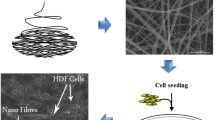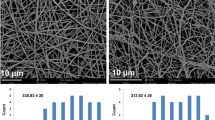Abstract
Highly porous ultrafine electrospun scaffolds, gelatin/poly(L-lactic acid) (PLLA) and chitosan/PLLA were prepared by blending gelatin and PLLA, chitosan and PLLA respectively. The biocompatibilities of these scaffolds were assessed by attachment, proliferation and viability of cells on them. The results indicated that over 30% WI-38 cells could attach to the gelatin/PLLA and chitosan/PLLA scaffolds at 2 h after seeding, while the attachment of the cells was only 15% on PLLA scaffolds. Both gelatin/PLLA and chitosan/PLLA scaffolds also exhibited a very good ability for proliferation of WI-38 cells. Cell growth on the gelatin/PLLA and chitosan/PLLA scaffolds showed dramatic improvement, indicating a much better biocompatibility in the blends contributed by gelatin and chitosan. 3-(4,5-dimethylthiazol-2-yl)-2,5-diphenyltetrazolium bromide (MTT) assay also demonstrated gelatin/PLLA showed better ability to enhance the growth and functions of the cells. These assays suggest that the electrospun gelatin/PLLA and chitosan/PLLA scaffolds are promising biomaterials with great biocompatibility for the development of skin tissue engineering.
Similar content being viewed by others
References
Dodson W W, Kalns J, Scruggs J, et al. Nitrotyrosine predicts healing in chronic diabetic foot wounds treated with hyperbaric oxygen [J]. Wounds, 1999, 11(6): 129–136.
Stankus J J, Freytes D O, Badylak S F, et al. Hybrid nanofibrous scaffolds from electrospinning of a synthetic biodegradable elastomer and urinary bladder matrix [J]. Journal of Biomaterials Science Polymer Edition, 2008, 19(5): 635–652.
Dong B, Arnoult O, Smith M E, et al. Electrospinning of collagen nanofiber scaffolds from benign solvents [J]. Macromolecular Rapid Communications, 2009, 30: 539–542.
Dillow A K, Lowman A M. Biomimetic materials and design: Biointerfacial stragies, tissue engineering, and targeted drug delivery [M]. New York: Marcel Dekker, 2002: 65–66.
Yang S F, Leong K F, Du Z H, et al. The design of scaffolds for use in tissue engineering. Part I. Traditional factors [J]. Tissue Engineering, 2001, 7(6): 679–689.
Chen G P, Ushida T, Tateishi T. Scaffold design for tissue engineering [J]. Macromolecular Bioscience, 2002, 2: 67–77.
Frenot A, Chronakis I S. Polymer nanofibers assembled by electrospinning [J]. Current Opinion in Colloid and Interface Science, 2003, 8: 64–75.
Huang Z M, Zhang Y Z, Kotaki M, et al. A review on polymer nanofibers by electrospinning and their applications in nanocomposites [J]. Composites Science and Technology, 2003, 63: 2223–2253.
Li W J, Laurencin C T, Caterson E J, et al. Electrospun nanofibrous structure: A novel scaffold for tissue engineering [J]. Journal of Biomedical Materials Research, 2002, 60: 613–621.
Yoshimoto H, Shin Y M, Terai H, et al. A biodegradable nanofiber scaffold by electrospinning and its potential for bone tissue engineering [J]. Biomaterials, 2003, 24: 2077–2082.
Khil M S, Cha D I, Kim H Y, et al. Electrospun nanofibrous polyurethane membrane as wound dressing [J]. Journal of Biomedical Materials Research Part B: Applied Biomaterials, 2003, 67: 675–679.
Verreck G, Chun I, Peeters J, et al. Preparation and characterization of nanofibers containing amorphous drug dispersions generated by electrostatic spinning [J]. Pharmaceutical Research, 2003, 20(5): 810–817.
Zeng J, Chen X, Xu X, et al. Ultrafine fibers electrospun from biodegradable polymers [J]. Journal of Applied Polymer Science, 2003, 89: 1085–1092.
Fang X, Reneker D H. DNA fibers by electrospinning [J]. Journal of Macromolecular Science: Physics, 1997, B36(2): 169–173.
Ohgo K, Zhao C, Kobayashi M, et al. Preparation of nonwoven nanofibers of Bombyx mori silk, Samia cynthia ricini silk and recombination hybrid silk with electrospinning [J]. Polymer, 2003, 44: 841–846.
Min B M, Lee G, Kim S H, et al. Electrospinning of silk fibroin nanofibers and its effect on the adhesion and spreading of normal human keratinocytes and fibroblasts in vitro [J]. Biomaterials, 2004, 25: 1289–1297.
Huang L, Negapudi K, Apkarian R, et al. Engineered collagen-PEO nanofibers and fabrics [J]. Journal of Biomaterials Science Polymer Edition, 2001, 12(9): 979–994.
Wnek G E, Carr M E, Simpson D G, et al. Electrospinning of nanofiber fibrinogen structures [J]. Nano Letters, 2003, 3(2): 213–216.
Li M, Guo Y, Wei Y, et al. Electrospinning polyaniline-contained gelatin nanofibers for tissue engineering applications [J]. Biomaterials, 2006, 27: 2705–2715.
Bhattarai N, Edmondson D, Veiseh O, et al. Electrospun chitosan-based nanofibers and their cellular compatibility [J]. Biomaterials, 2005, 26: 6176–6184.
Geng X, Kwon O H, Jang J. Electrospinning of chitosan dissolved in concentrated acetic acid solution [J]. Biomaterials, 2005, 26: 5427–5432.
Um I C, Fang D, Hsiao B S, et al. Electro-spinning and electro-blowing of hyaluronic acid [J]. Biomacromolecules, 2004, 5: 1428–1436.
Son W K, Youk J H, Park W H. Preparation of ultrafine oxidized cellulose mats via electrospinning [J]. Biomacromolecules, 2004, 5: 197–201.
Sun J S, Wu S Y H, Lin F H. The role of musclederived stem cells in bone tissue engineering [J]. Biomaterials, 2005, 26: 3953–3960.
Mao J S, Cui Y L, Wang X H, et al. A preliminary study on chitosan and gelatin polyelectrolyte complex cytocompatibility by cell cycle and apoptosis analysis [J]. Biomaterials, 2004, 25: 3973–3981.
Lerman O Z, Galiano R D, Armour M, et al. Cellular dysfunction in the diabetic fibroblasts: Impairment in migration, vascular endothelial growth factor production, and response to hypoxia [J]. American Journal of Patbology, 2003, 162(1): 303–312.
Ciapetti G, Cenni E, Pratelli L, et al. In vitro evaluation of cell/biomaterial interaction by MTT assay [J]. Biomaterials, 1993, 14: 359–364.
Marois Y, Guidoin R, Roy R, et al. Selecting valid in vitro biocompatibility tests that predict the in vivo healing response of synthetic vascular prostheses [J]. Biomaterials, 1996, 17: 1835–1842.
Patrick C W, Mikos A G, Mcintire L V, et al. Frontiers in tissue engineering [M]. New York: Pergamon Press, 1998: 121–137.
Sechriest V F, Miao Y J, Niyibizi C, et al. GAGaugmented polysaccharide hydrogen: A novel biocompatible and biodegradable material to support chondrogenesis [J]. Journal of Biomedical Materials Research, 2000, 49: 534–541.
Qin Ting-wu, Yang Zhi-ming, Cai Shao-xi, et al. Interaction of cell adheision to materials in tissue engineering [J]. Chinese Journal of Reparative and Reconstructive Surgery, 1999, 13(1): 31–37 (in Chinese).
Inouye K, Kurokawa M, Nishikawa S T, et al. Use of Bombyx mori silk fibroin as a substratum for cultivation of animal cells [J]. Journal of Biochemical and Biophysical Methods, 1998, 37: 159–164.
Boyan B D, Hummert T W, Dean D D, et al. Role of material surfaces in regulating bone and cartilage cell response [J]. Biomaterials, 1996, 17: 137–146.
Author information
Authors and Affiliations
Corresponding author
Additional information
Foundation item: the Project of the Science and Technology Commission of Shanghai Municipality (No. 11nm0505100), the China Postdoctoral Science Foundation (No. 2012M510116) and the Fundamental Research Funds for the Central Universities (No. 0500219160)
Rights and permissions
About this article
Cite this article
Li, Jb., Han, J. & Ren, J. Interaction of human fibroblasts with electrospun composites gelatin/PLLA, chitosan/PLLA and PLLA fibrous scaffolds. J. Shanghai Jiaotong Univ. (Sci.) 17, 559–566 (2012). https://doi.org/10.1007/s12204-012-1325-6
Received:
Published:
Issue Date:
DOI: https://doi.org/10.1007/s12204-012-1325-6




